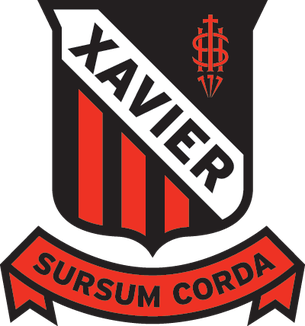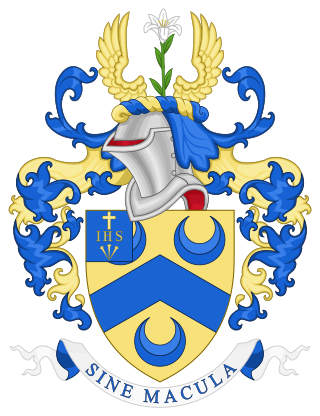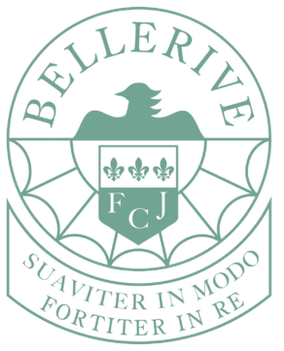The Xaverian Brothers or Congregation of St. Francis Xavier are a Roman Catholic religious institute founded by Theodore James Ryken in Bruges, Belgium, in 1839 and named after Saint Francis Xavier. The institute is dedicated to education.

Xavier College is a Roman Catholic, day and boarding school predominantly for boys, founded in 1872 by the Society of Jesus, with its main campus located in Kew, an eastern suburb of Melbourne, Victoria, Australia. Classes started in 1878.

Xaverian College is a Roman Catholic college in Manchester, England, two miles south of the city centre in Rusholme. Established in 1862, Xaverian College has become one of the most oversubscribed Sixth form college in Greater Manchester, along with Loreto College and Ashton Sixth Form College. It consistently ranks in the top 10 facilities for 16-18 education. Xaverian College is a member of the Association of Colleges. As of 2019, the acceptance rate is 30%.

St Ignatius College is a Catholic voluntary aided secondary school for boys aged 11–18 in Enfield, London, England, founded by the Society of Jesus in 1894 and completely moved to its present site by 1987. It was formerly a grammar school, only accepting boys who had passed the Eleven plus exam. Former students include Alfred Hitchcock, George Martin, and Cardinal John Heenan.

Mount St Mary's College is an independent, co-educational, day and boarding school situated at Spinkhill, Derbyshire, England. It was founded in 1842 by the Society of Jesus, and has buildings designed by notable architects such as Joseph Hansom, Henry Clutter and Adrian Gilbert Scott. The school is a member of the Headmasters' and Headmistresses' Conference and the Catholic Independent Schools Conference.

Salesian College is an 11–18, selective independent Roman Catholic day school in Farnborough, Hampshire, England. Founded in 1901 as a small preparatory school for boys, it soon expanded to provide secondary education owing to its increasing popularity. In November 2022, the school had a total of 634 pupils enrolled, 129 in the Sixth Form. For the 2007–08 academic year, the College announced that it would admit girls into the Sixth Form for the first time.
St Patrick's Grammar School, Armagh, is a Roman Catholic boys' non-selective voluntary grammar school in the city of Armagh, Northern Ireland. The present-day school was officially opened on Thursday, 27 October, 1988, by the late Cardinal Tomás Ó Fiaich, the then Chairman of the Board of Governors, and was the result of the amalgamation of two of Northern Ireland's oldest grammar schools, Christian Brothers' Grammar School and St. Patrick's College, both of which had traditions stretching back as far as the 1830s.
Notre Dame is a catholic Sixth Form College in Leeds, West Yorkshire, England. The college is situated on Saint Mark's Avenue, near the engineering departments of the University of Leeds in Woodhouse, Leeds. It is near the St Mark's Church, Woodhouse, Leeds, and the Leeds Universities Catholic Church and Centre. It provides A-Level and vocational full-time courses in further education.
St Boniface's Catholic College is a secondary school for boys, under the direction and trustees of the Roman Catholic Community in the Plymouth area in the South West of England. Founded in 1856 as an independent boarding and day school for "young Catholic gentlemen" in the West Country, it is now a comprehensive school. The College is named for St Boniface who was born in Crediton, Devon and is the patron saint of Germany. The school has a list of distinguished former pupils including Air Chief Marshal Sir John Gingell GBE KCB KCVO, the writer and intelligence agent Alexander Wilson, and Sir Julian Priestley KCMG, Secretary General of the European Parliament from 1997 to 2007.

St Peter's College is a Catholic secondary school for boys in the Edmund Rice tradition, and dedicated to St Peter. It is located in the central Auckland area of Grafton, Auckland, New Zealand. With a roll of over 1300, the school is one of the largest Catholic schools in New Zealand. St Peter's College was established in 1939 as a successor of Auckland's earliest school and of St Peter's School, founded in 1857. However, Auckland also had another Catholic secondary school dedicated to St Peter, Hato Petera College or St Peter's Māori College, which existed for 90 years from 1928 until 2018 in Northcote.
Our Lady of Sion School is an inter-denominational, independent school for male and female students, founded in 1862 and located in Worthing, West Sussex, on the south coast of England.
Notre Dame RC School is a Roman Catholic school for girls in Derriford, Plymouth, England. Its sister school is St Boniface's Catholic College.

Notre Dame Catholic College is a Catholic secondary school and sixth form in Everton, Liverpool, England. Founded by the Sisters of Notre Dame de Namur, it was a girls' school for most of its history but became coeducational from September 2012.
Battersea Grammar School was a Voluntary-Controlled Secondary Grammar School in South London. It was established in Battersea in 1875 by the Sir Walter St John Trust and moved to larger premises in Streatham in 1936.

Newton Prep School is located in Battersea, South London. It opened in September, 1991 with 70 pupils. The founder is Dr Farouk Walji. Newton Prep has over 600 pupils. It accepts pupils aged 3 to 13, from nursery until year 8.

Bellerive FCJ Catholic College is an all-girls secondary school and a coeducational sixth form located on Windermere Terrace in Liverpool. It is a Roman Catholic school, and has academy status.
For the school of the same name in Quetta, Pakistan, see St Francis Grammar School.

Mayfield College is a defunct Roman Catholic boys' boarding school founded as the Holy Trinity Orphanage For Boys in 1865–1866 by the American-born Dowager Duchess of Leeds, Louisa Catherine Caton, one mile from Mayfield, East Sussex. The main building and attached chapel were built in the Gothic style, primarily of red brick and are Grade II listed, having been designed by E. W. Pugin. After closure in 1999 both the main building and chapel were converted into luxury apartments now called collectively Mayfield Grange. Officially opening in 1868 it was also known as the Xaverian Brothers School, St Xavier's College and Xaverian College at various times. Mayfield College was built as one of a pair of orphanages at the Duchess's expense, the other originally known as St. Michael's Orphanage for Girls in Bletchingley, East Sussex, also designed by Pugin.
St. John Bosco College is a coeducational Roman Catholic secondary school and sixth form, located in Battersea in the London Borough of Wandsworth, England.
St Paul's Catholic High School, also known as St Paul's RC High School, is a mixed Roman Catholic secondary school located in the Newall Green area of Manchester, England.










